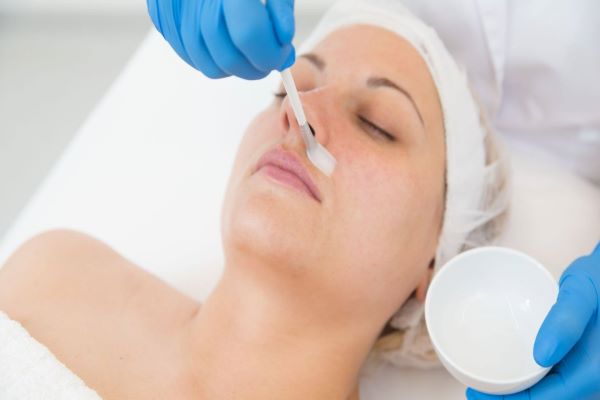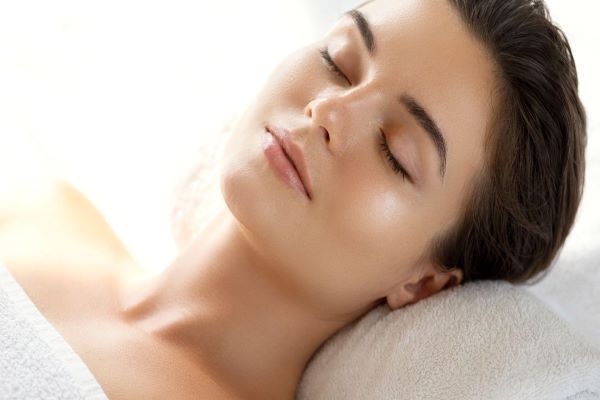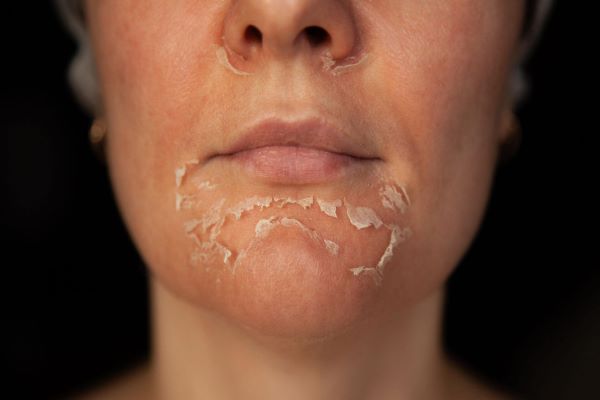We’ve all seen those amazing, flawless-skinned people and wondered how in the world they do it. Well, wonder no more! I’m here to tell you that 99% of the time, they have had some kind of chemical peel done. Ok, so that’s not totally true, but the best at-home chemical peel for your skin type can definitely help improve your skin tone and texture.
The thing is, unless you’re a plastic surgeon or dermatologist, you’re not going to be able to administer a professional-grade peel at home. That doesn’t mean there aren’t some great at-home chemical peel products out there – ones that can give you noticeable results without leaving your skin red, irritated, and flaky for days on end.
In this post, I’ll share 10 of my favorites. Keep reading for tips on how to do a DIY chemical peel at home using these products!
What are chemical peels and their benefits?

Chemical peels are a type of skin care treatment that uses chemicals to peel away the top layer of skin.
This can improve the appearance of your complexion by removing dead skin cells and impurities that may be clogging up your pores, revealing newer, brighter, and smoother-looking skin beneath.
Chemical peels can also help reduce the appearance of wrinkles, sun damage, and acne scars. In short, they can do wonders for your complexion!
Chemical peels offer a lot of benefits similar to other procedures like microdermabrasion or laser skin resurfacing.
They are also less expensive than laser skin resurfacing (though more expensive than microdermabrasion).
Chemical peels are more targeted for specific skin concerns than microdermabrasion (but less targeted than laser skin resurfacing).
You can either do professional-grade chemical peels through your dermatologist or certified skincare professional, or do it yourself at home depending on your skin concern, skin type, and what level of exfoliation your skin can handle.
Professional-grade chemical peels

If you’re looking for a more intense skin treatment than what you can get from an at-home peel, then you may want to consider a professional-grade chemical peel.
Professional-grade peels can be administered by a plastic surgeon or dermatologist, and they involve using a more powerful exfoliating agent than what is available over the counter.
This type of peel can achieve better results in terms of skin tone and texture, as well as reduce the appearance of wrinkles, sun damage, and acne scars.
Keep in mind that professional-grade peels are more expensive than at-home peels, and they can also be more painful and cause more skin irritation.
If you’re thinking of getting a professional-grade peel, make sure to do your research first and talk to your doctor about which type of peel would be best for your skin type and concerns.
What are the available types of at-home chemical peels?
When it comes to at-home chemical peels, there are a few different types you can choose from, depending on your skin type and concerns.
Here are the three most common types:
1. Alpha hydroxy acids (AHA) peels
Alpha hydroxy acids are a common type of chemical peel available over the counter.
They are effective in exfoliating the skin and come in a variety of forms, such as glycolic acid, lactic acid, and mandelic acid.
For example, a glycolic acid peel is commercially available in concentrations of 20 to 70%
AHAs are best for those with dry skin, as they can help to improve hydration and skin texture.
They are also effective in reducing the appearance of wrinkles, fine lines, and age spots.
2. Beta hydroxy acids (BHA) peels
Beta hydroxy acids are perhaps the most common type of chemical peels available over the counter.
BHA are similar to AHAs in that they are effective in exfoliating the skin, and they can come in the form of salicylic acid. However, BHAs are oil-soluble, which means they can penetrate deeper into the pores to remove impurities and excess sebum.
A salicylic acid peel, for example, is commercially available in concentrations of 5 to 30%.
This makes them ideal for those with oily or acne-prone skin, as they can help to unclog pores, help reduce the appearance of blemishes and blackheads, and prevent breakouts.
BHA peels are best for those with sensitive skin, as they have anti-inflammatory and soothing properties, and are less harsh than AHAs.
BHAs are also effective in reducing the appearance of wrinkles, fine lines, sun damage, and age spots.
3. Trichloroacetic acid (TCA) peels
Trichloroacetic acid is a type of chemical peel that is available by prescription only.
It is a more powerful exfoliant than AHAs or BHA peels and is only available through a doctor’s office or dermatology clinic.
TCA peels can achieve better results in terms of skin tone and texture than other types of at-home chemical peels. They can also help reduce the appearance of wrinkles, sun damage, and acne scars.
However, TCA peels can also be more painful and cause more skin irritation than other types of chemical peels.
If you’re thinking of getting a TCA peel, make sure to do your research first and talk to your doctor about whether or not this type of peel is right for you.
What are the benefits of at-home chemical peels?

At-home chemical peels offer a number of benefits for your skin.
They can help to improve skin texture and tone, reduce the appearance, wrinkles, fine lines, and age spots, and help to unclog pores, reduce and prevent acne breakouts.
At-home chemical peels can also be a great way to save money on professional treatments.
If you’re thinking of using at-home chemical peels, make sure to do your research and talk to your doctor to ensure that they’re right for you.
What are the side effects of at-home chemical peels?

The side effects of at-home chemical peels vary depending on the type of peel you use.
Generally, the side effects of at-home chemical peels are mild and include skin irritation, redness, and dryness.
However, more serious side effects can occur if you don’t follow the instructions carefully or if you have sensitive skin.
Some of the more serious side effects of at-home chemical peels include crusting, chemical burns, scars, and hyperpigmentation.
Make sure to talk to your doctor about the possible side effects of at-home chemical peels before you start using them.
How often should you use at-home chemical peels?
The frequency with which you use at-home chemical peels depends on the type of peel you use and your skin type.
It’s important to start slow and increase the frequency of your at-home chemical peels gradually. This will help you avoid any skin irritation or other side effects.
Generally, doing chemical peel once or twice a week is all you need to avoid over-exfoliating your skin or causing damage to your skin microbiome.
Those with sensitive skin may only be able to tolerate using at-home chemical peels less frequently than those with tougher skin.
Make sure to follow the instructions on the product you’re using to ensure that you’re not using it too often.
How should you prepare before an at-home chemical peel?
The preparation for an at-home chemical peel depends on the type of peel
The preparation for an at-home chemical peel depends on the type of peel you are using.
– Avoid direct sunlight: For example, those using AHAs or BHA peels should avoid sun exposure before and after peeling, as this can increase the risk of skin irritation.
If you must go out in the sun for any unavoidable reason, make sure to use sunscreen with an SPF of 30 or higher to protect your skin.
– Avoid other exfoliants: You should also avoid using other exfoliating products, such as scrubs or physical exfoliants, in the days leading up to your chemical peel.
This will help to ensure that your skin is properly prepped for the treatment and avoid any further irritation.
– Avoid alcohol and caffeine: Those using TCA peels should avoid alcohol and caffeine for at least 24 hours before the peel, as these can increase the risk of skin irritation.
– Avoid Retinol: It’s also important to avoid using any retinoids (such as Retin-A), or any other products with acids such as AHA, BHA, or vitamins for a few days (two to three days) before a peel, as they can make your skin more sensitive to sunlight.
– Use Sunscreen: When it comes to sunscreen, a 2018 study found that it is best to use a broad spectrum sunscreen for at least 2 months before your at-home chemical peel to help reduce the risk of post-inflammatory hyperpigmentation (PIH).
Ideally, you want to use a sunscreen with an SPF of 30 or higher, as well as a physical blocker such as zinc oxide.
– Stay hydrated: In addition, stay hydrated before your chemical peel.
– Read instructions carefully: Make sure to read the instructions carefully before starting any at-home chemical peel.
– Talk to your doctor: Make sure to talk to your doctor about how to prepare for an at-home chemical peel before you start using them.
What should you do after an at-home chemical peel?
– Read the post-peel instructions: it’s important to follow the instructions provided by the product you used. This will help to ensure that your skin heals properly and avoid any further irritation.
– Avoid the exfoliants: In general, you should avoid using other exfoliating products, sun exposure, and makeup for at least 24 hours after your peel.
– Stay hydrated: You should also drink plenty of water, as this will help to keep your skin hydrated and promote healing.
– Use a gentle, non-abrasive cleanser to clean your skin.
– Use a Sunscreen: In addition, make sure to use sunscreen with an SPF of 30 or higher for at least 2 weeks (and ongoing) both indoors and outdoors after your peel. This will help to prevent any further irritation and protect your skin from the sun.
– Don’t pick at your skin: It is important to avoid picking at your skin, as this can lead to infection, further irritation, and scarring.
– Avoid scrubbing while it’s healing: Just as you shouldn’t pick at your skin, you also want to avoid scrubbing for at least 3 to 4 days while it’s healing. Afterward, if you must exfoliate (you really don’t need to), don’t scrub too hard. This can further irritate your skin and lead to scarring.
If you have any further questions about at-home chemical peels, feel free to talk to your doctor.
When should you see a doctor?
If you experience any serious side effects, such as intense pain, excessive redness, severe skin irritation, burning, or blistering, you should see a doctor right away.
You should also talk to your doctor if you have any concerns about using at-home chemical peels.
Your doctor can help you determine if at-home chemical peels are safe for you to use and can offer advice on how to use them properly.
As an amazon associate I earn from qualifying purchases. Full discolsure…
What are the best at-home chemical peel products?
The following are 10 of the best at-home chemical peel products:
1. Dr. Dennis Gross Alpha Beta Extra Strength Daily Peel: These pre-soaked pads contain a blend of AHAs and BHAs to help exfoliate your skin and diminish the appearance of fine lines, wrinkles, pores, and dark spots. It also helps improve skin tone and texture.
2. First Aid Beauty Radiance Pads: These gentle glycolic acid and lactic acid pads are perfect for those with sensitive skin. They help to exfoliate your skin and reveal a brighter complexion.
3. Murad Daily Clarifying Peel: This at-home peel uses glycolic acid, salicylic acid, and retinoids to help improve your skin’s texture and reveal a brighter complexion. It’s suitable for all skin types.
4. Perfect Glycolic Acid 50% Gel Peel: This at-home gel peel contains 50% glycolic acid, making it one of the strongest peels available. It helps to improve your skin’s texture and brighten your complexion. It also contains retinol to help reduce the appearance of wrinkles. Extracts from green tea, chamomile, cucumber, and comfrey help to soothe your skin.
5. Bliss that’s Incredi-peel: This at-home peel contains10% glycolic acid, as well as vitamin E, licorice root extract, calendula flower extract, witch hazel, and glycerin to help exfoliate and brighten your skin, reduce the appearance of fine lines and discoloration, and improve your complexion. It can also help soothe and hydrate the skin.
6. Peter Thomas Roth | Even Smoother Glycolic Retinol Resurfacing Peel Pads: These pads contain a blend of 20% glycolic acid, 1.5% time-released microencapsulated retinol, and glycerin to help improve your skin’s texture and reduce the appearance of fine lines, wrinkles, pores, and dark spots. They also help to brighten your complexion.
7. YEOUTH Glycolic Acid 30% Gel Peel: This at-home gel peel contains 30% glycolic acid to help improve your skin’s texture and brighten your complexion. The added retinol and green tea help to reduce the appearance of wrinkles and fine lines.
8. Juice Beauty GREEN APPLE Peel: This at-home peel uses organic fruit acids (e.g. glycolic acid, lactic acid, and vitamin C) and to help brighten your complexion, reduce the appearance of pores, and improve your skin’s texture. It also contains vitamin E and green tea to help protect your skin from free radical damage.
9. QRxLab’s Glycolic Acid 20% Resurfacing Pads: These at-home pads contain 20% glycolic acid to help improve your skin’s texture and brighten your complexion. They also help to reduce the appearance of fine lines, wrinkles, and pores. It also contains green tea, vitamin B5, vitamin C, and Vitamin E, as well as Calendula, and allantoin to help soothe and protect your skin.
10. Dermalogy by Neogenlab’s Bio-Peel Gauze Peeling Green Tea: These at-home pads contain green tea, lactic acid, and glycolic acid to help brighten your complexion and improve your skin’s texture. They also help to reduce the appearance of fine lines, wrinkles, and pores. Antioxidants and anti-inflammatory extracts such as Camellia Sinensis Leaf and Tea Tree Extracts help to soothe and protect your skin.
How to do a DIY chemical peel using these products
This will ensure that the product is effective in exfoliating your skin.
- Start by cleansing your face with a gentle cleanser.
- Apply the chemical peel to your face and neck, avoiding the area around your eyes.
- Leave the peel on for the recommended amount of time, then rinse it off with lukewarm water.
- Apply a soothing moisturizer with hydrating and antioxidant ingredients like hyaluronic acid and niacinamide to your face and neck.
DIY chemical peels can be a great way to achieve a brighter, smoother complexion from the comfort of your own home.
The results that can be achieved with a chemical peel: Highlights
Chemical peels can help improve the appearance of:
-Fine lines and wrinkles
-Dark spots and hyperpigmentation
-Acne scars
-Pore size
-Sun damage
-Sagging skin
If you are looking for a way to achieve a brighter, smoother complexion, then a chemical peel may be right for you. Be sure to do your research and find the perfect product for your skin type to get the best results!
Three FAQs about at-home chemical peels
What are the Do’s and Don’ts of using at-home chemical peels?
There are a few things you should keep in mind when using at-home chemical peels:
Do’s
– Do a patch test on a small area of skin before using the peel on your face to make sure you’re not allergic to any of the ingredients.
– Follow the instructions carefully.
– Apply sunscreen after using a chemical peel, as your skin will be more sensitive to UV rays.
Don’t
– Don’t leave the peel on for longer than recommended, as this could cause irritation.
– Don’t use on broken or inflamed skin.
– Don’t forget to moisturize after using a chemical peel!
What are the side effects of at-home chemical peels?
Side effects from at-home chemical peels are usually mild and include:
– Redness
– Dryness
– Peeling
– Irritation
If you experience any severe side effects, stop using the product and consult a doctor.
Are at-home chemical peels safe?
Yes, at-home chemical peels are safe when used as directed. Be sure to do a patch test before using them on your face, and follow the instructions carefully to avoid any irritation. If you experience any severe side effects, stop using the product and consult a doctor.
Conclusion
At-home chemical peels can be a great way to achieve brighter and smoother skin without spending a fortune on professional treatments. There are a variety of different types of chemical peels available, so it’s important to do your research before buying one. Make sure to follow the instructions carefully for best results!
Leave a comment
Do you have any questions or tips about at-home chemical peels? Let us know in the comments below!
Disclaimer: The information in this article is for educational purposes only, and should not be taken as medical advice. If you have any concerns or questions about your skin, please consult a doctor or dermatologist.
